Revision drives learning. Getting students to revise rather than merely edit requires teaching students how to use feedback. Using feedback boils down to decision-making: How does this feedback help me? What do I do to address it? A revision plan is a place for students to think through their options, and it’s a place for instructors to improve students’ decision-making.
This post describes three elements for teaching students to compose better revision plans.
- understanding how a revision plan works to scaffold writers’ decisions
- understanding how to scaffold writers’ reflections
- understanding the role of practice.
Assign Revision Plans to Scaffold Writers’ Decisions
Writers make three kinds of decisions about their feedback: They select peer comments to use, prioritize them, and reflect on how to change their drafts in response to the comments.
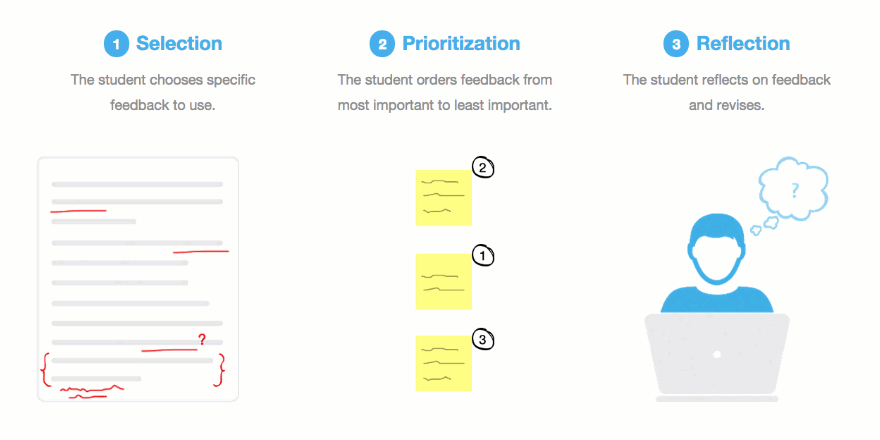
In Eli Review, revision plans unite pedagogy and technology.
Pedagogically, revision plan assignments give students an opportunity to articulate their revision decisions. Plans allows instructors to see students’ thinking between drafts so that they can intervene, guiding students toward the most important goals at that moment in the writing process.
Technically, revision plans turn the selection, prioritization, and reflection decisions into actions in the app:
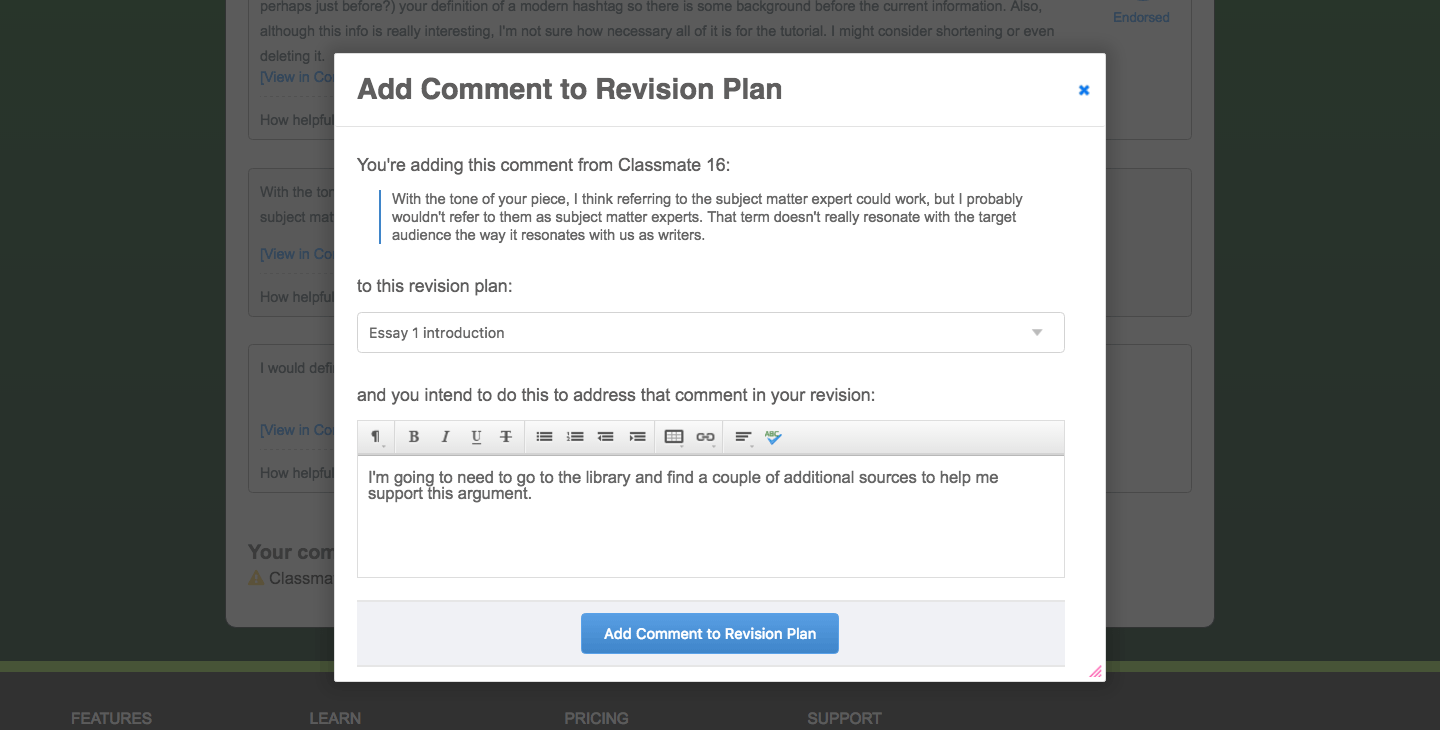
First, students click “Add to revision plan” on any comment, which opens a comment box that encourages writers to explain the actions they’ll take on reviewers’ feedback.

Second, on the revision plan, the drag-and-drop interface invites writers to figure out how important each piece of feedback is.
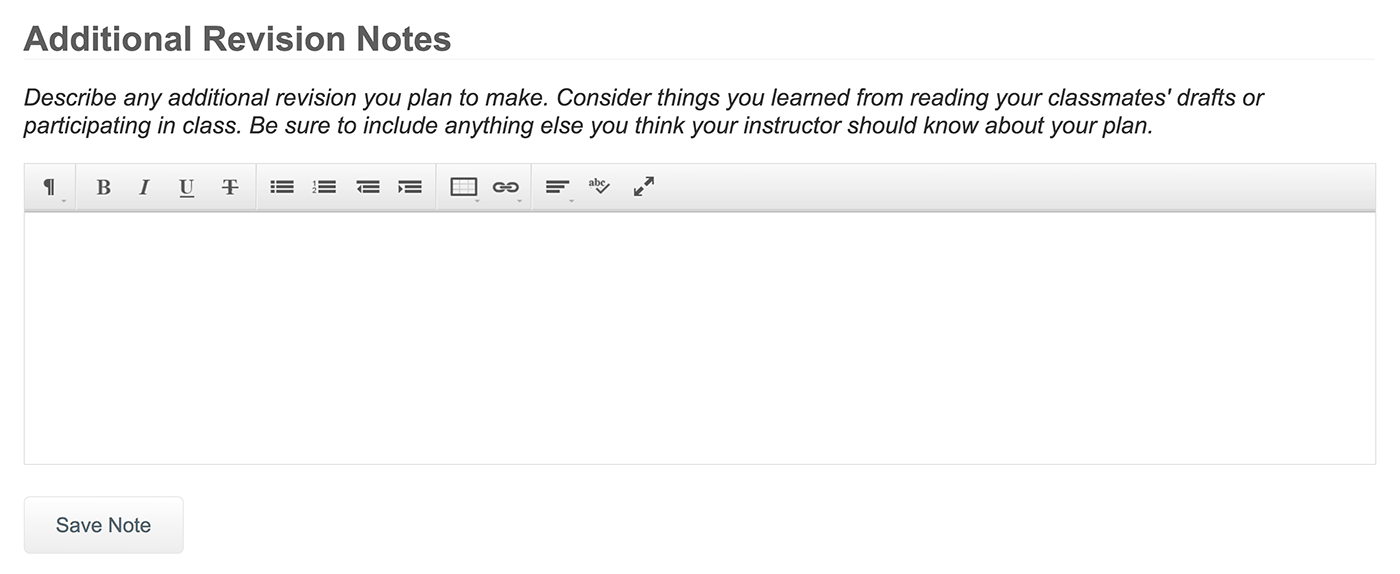
Third, the “Additional Revision Notes” option gives writers a space to add revision goals that emerged from checklists and ratings in the review, reading others’ drafts, discussion of models in class, and/or small group discussion. It encourages students to be accountable for all the feedback exchanged in the class, not just the feedback they received personally.
In Eli, building a revision plan helps students go through the motions of effective decision making about how to use peer feedback.
Provide Direct Instruction on How to Reflect on Feedback
Revision plans push students to think like writers. For novice writers, learning to recognize their own strengths and weaknesses is challenging. Making sense of feedback that is transformative, contradictory, or thin on details is tough. Learning to connect feedback, criteria, and strategies with their own purposes for writing and the needs of the intended audience takes practice. To be successful, writers have to learn the moves of effective reflection on drafts in progress. They have to learn what to talk about and how to express their goals.
Revision plans are not a field of dreams. If students build revision plans, revision insights may or may not come. The app can guide students through the motions, but instructors must teach writers how to get better at explaining their decisions.
Explain the Purposes of Revision Plans
One way to help students invest in improving their reflection is to explain the purpose of the task. Instructors can point out that revision plans share characteristics with two other genres: feedback response letters to editors and portfolio cover letters.
- Response to Editors. Revision plans are similar to letters that writers who have been invited to revise send to academic/commercial editors after receiving peer feedback. These letters show the editor how writers plan to address reviewers’ critiques of the content, organization, style, and technical features of the article. [Read more about teaching the COST of revision.] If approved, the writer executes those revisions and submits a new version.
- Portfolio Cover Letters. Revision plans are also similar to cover letters for portfolio assessments. In both, writers talk about writing processes, making explicit how they decided to approach a written product. In a portfolio cover letter, writers need to say what they revised, why they were persuaded to revise, which strategies they use to revise, and how effective the revision turned out to be. Only that last move isn’t needed for a revision plan.
Using these two genres as examples, instructors can explain to students that revision plans accomplish two goals:
- Seek permission to revise in specific ways, which is particularly comforting for students who want assurance from instructors that they are on the right track.
- Show the breadth and depth of what they are thinking and doing as writers, which is particularly comforting for students whose hard work doesn’t yield a high-scoring draft.
When students understand the purposes of revision plans, they are more likely to be thoughtful in composing them.
Describe How to be More Effective in Revision Plans

Another way to scaffold students’ reflection is to be very clear about what they need to do next to improve their reflection. Because reflection asks students to integrate self-awareness and discipline-based knowledge about writing, it’s helpful to think about students’ growth in composing revision plans on a developmental continuum.
Derek Miller, who teaches 11th Grade AP Language Arts at Royal Oak High School in Michigan, made revision plans the focus of his teacher-researcher work this year. To mirror the developmental continuum for reviewers that he, Susan Golab, and I worked on last year, Derek composed one for revision plans (full continuum below):
- Level 1 plans fail to address the most important criteria in the assignment.
- Level 2 plans zero in on content changes but don’t entertain new ideas or new organizational/style strategies for revising the draft.
- Level 3 plans shows awareness of the writer’s own choices in delivering the message, but have minimal, vague explanations for why and how the writer will revise.
- Level 4 plans fully explain what, how, and why the writer will revise the purpose, ideas, and style of the draft.
- Level 5 plans have all the characteristics of a Level 4, but go on to consider alternatives and weigh the possible effects of each on readers.
These levels help instructors describe what students can currently do. In the full continuum (below), Derek includes the things writers need to do to move up to the next level. The continuum becomes a map that helps students know where they are and what they need to do to improve.
A developmental continuum like this one isn’t that useful for grading. Students might write Level 2 drafts for several weeks until they’re ready to go deeper. Instead, these levels can help instructors and students understand current progress and how to level up.
| Level | Descriptor of Proficiency | Moves to Level Up |
|---|---|---|
| 1 | Student demonstrates ineffective reflection on writing choices. Describes aspects of the task unrelated to key elements of text, or choices of composition. |
|
| 2 | Student describes elements and choices related subject and content of text. Extends, clarifies, or develops claims, ideas, or examples from the text itself without reflecting directly on compositional choices, elements of writing, or changes in thinking. |
|
| 3 | Student reflections demonstrate a partially developing sense of understanding of text elements and author’s choices. Student comments, observes, and evaluates based on a vague sense of elements of craft. Description may be limited to choices, or thinking, or process, but connections between compositional choices and thinking are not clear or specific. Or very limited understanding of compositional choices. |
|
| 4 | Student reflections are based on shared understandings of elements of craft and author’s choices. Student identifies elements and compositional choices about those elements and makes specific, explicit connections between choices and changes in thinking. Comments clarify reasoning behind choices and evaluate success and failure by relating choices to goals. |
|
| 5 | Student reflections are insightful about shared understandings of elements of craft and author’s choices. Student identifies elements of writing and compositional choices, makes specific, explicit connections between choices and changes in thinking, and the student explores and questions possible outcomes related to the range of choices available. Student clearly evaluates the impact of choices on success and failure of specific goals. Reflections demonstrate the author’s ability to generate questions about, reflect on, and revise the work. |
Practice Is Part of the Scaffold
The most important ingredient in student improvement is practice. That’s true for writing, for feedback, and for revision plans. My own classroom experience at a community college suggests that a majority of students improve on giving helpful feedback by the third round of review, but it might be the fifth or sixth write-review-revise cycle before there’s noticeable improvement in revision plans. Derek expects his HS juniors to recognize the importance of giving good feedback by the third review, if not before, and from that point to begin to see how good feedback helps them to make better revision plans. As with most things in teaching, patience and consistency pay off.
Derek’s focus on documenting students’ growth in revision plans has led to amazing results. Here’s an example of a revision plan composed by a student in his class who began the term at a Level 2 and is now consistently writing Level 4 plans.
The (second) revision plan shows us that the student is thinking like a writer. The plan is precise about the draft’s current problems with attention to audience, purpose, and their own goals. It’s weighing different options and acknowledging the personal commitments that influence the stance.
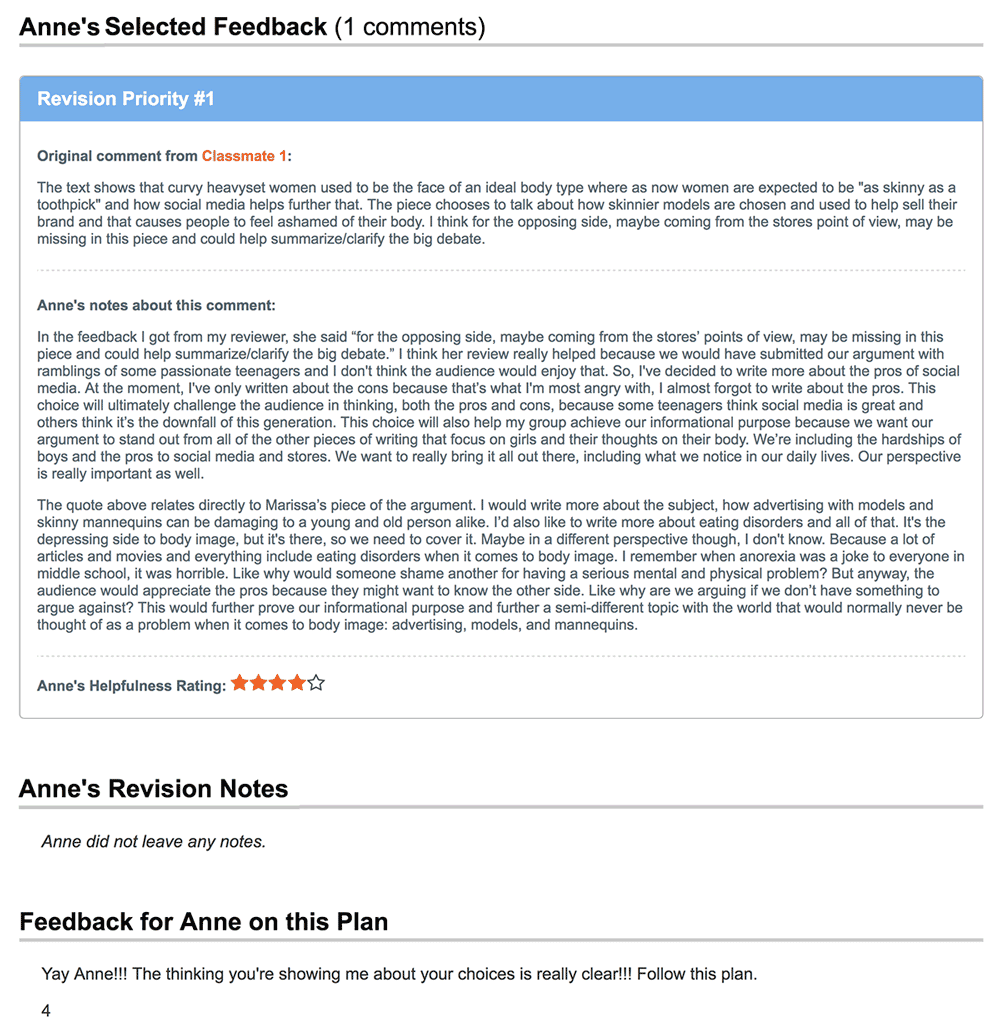
This kind of reflection will help the student better revise this draft. More importantly, it will help this writer get better at revising unfamiliar writing tasks in contexts where there isn’t a strong scaffold. Learning to make decisions like writers—the aim of a revision plan—equips students to make better revisions.
Bottom-Line: App + Teaching + Tracking Growth = Better Learning
Students write better revision plans when they understand how the revision plan’s technology supports the decision-making that will help them become better writers. Their investment in planning increases when the purpose is clear. Their skills improve with specific goals for leveling-up and regular practice.
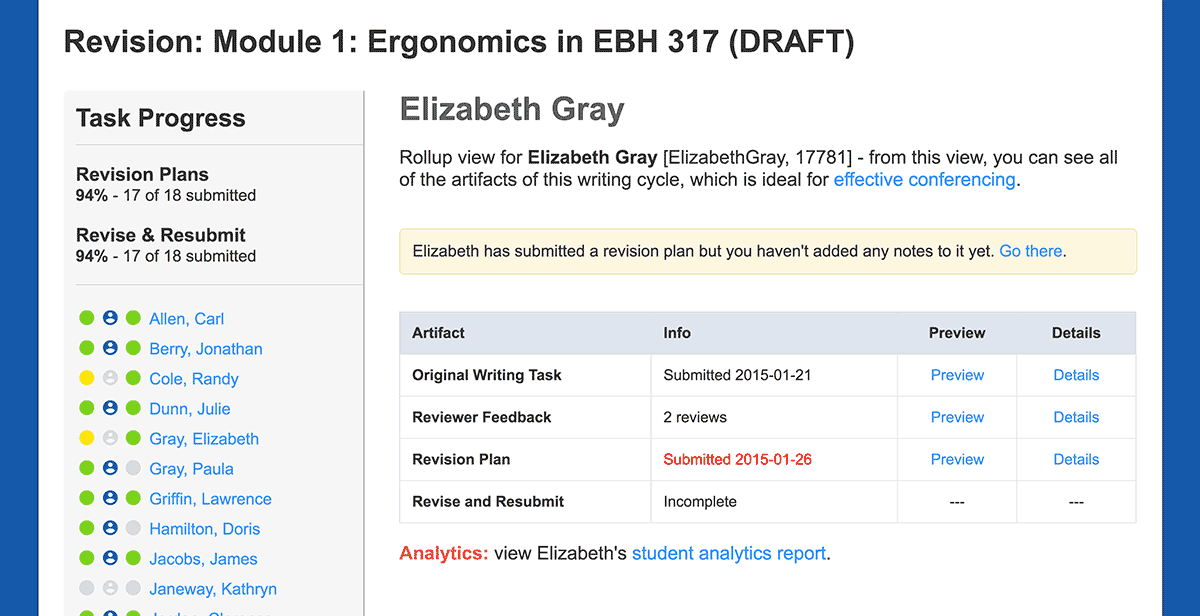
Revision plans can be accomplished in many ways, including on paper. Eli’s revision plan, however, has two advantages: greater visibility and efficiency. Eli collates all the artifacts of a writer’s process on one screen. Instructors can see students’ decisions in the context of their writing and peer feedback, saving them time from sifting through a stack of papers or a collection of files. When instructors give feedback on students’ plans, they provide just-in-time coaching so that students not only produce better revisions but also become better writers.



